Media | Articles
9 roadside repairs that tested my DIY limits
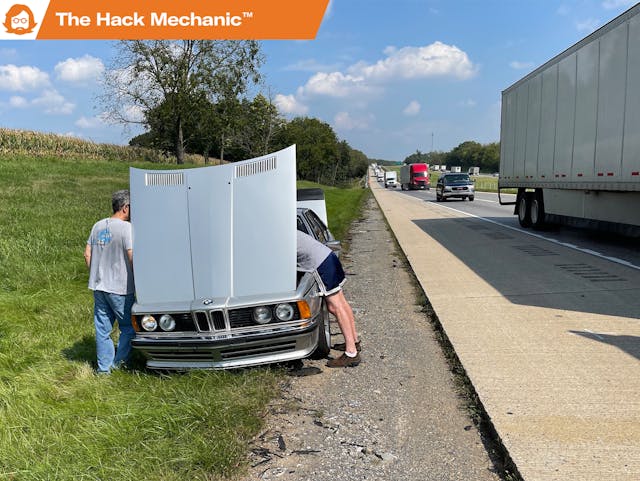
If you’re tooling around close to home in a vintage car, breakdowns aren’t really that big of a deal. Your Hagerty or AAA coverage will probably tow the car home for free or close enough, and you can fix it there. But if you’re road-tripping a car, breakdowns are a much bigger deal. Even if the cause is something you think you can fix, you really don’t want to be in a situation where you need to be under a car when trucks are whipping past only 10 feet away. Anything you know is wrong with a car that is likely to put it in the breakdown lane really should be fixed before a trip.
That having been said, breakdowns happen, and when the cause is obvious and easily addressable, roadside repairs get made. To be clear, whenever possible, don’t literally repair it roadside—if you’re on the highway, limp the car to an exit and find a parking lot instead. Cooling system and oil pressure issues, however, carry a special urgency, as failure to act immediately can result in a cracked head or a lunched engine.
When a roadside repair is ingenious or difficult, it turns into the stuff of legend. I’ve heard stories about broken fan belts in Volkswagens being addressed (or undressed) by convincing a female companion to surrender her panty hose and fashioning a belt out of it (likely a relationship-cementing or a relationship-ending event). One South African friend told me a story about engine failure in a remote area and a weeks-long process of walking miles and hitchhiking while carrying a cylinder head to and from a machine shop. And I witnessed two good friends of mine replace a BMW 2002’s blown head gasket in a hotel parking lot in under an hour and a half.
Now, nothing I’ve done approaches these feats. But after 47 years of wrenching, these are the roadside repairs that stand out above the usual wiring-up of hanging exhausts, reseated distributor caps, “your alternator won’t charge without excitation current from the battery warning light” fixes, and getting a car to start by tapping on the positive battery clamp, the starter, or the electric fuel pump, then going “Ayyyy” like Fonzie.
1. Water pump failure in the Triumph GT6+
In high school, I had been a bicycle guy—riding bikes, fixing bikes, pulling bikes out of the trash and rejuvenating them with parts from other bikes. The summer before college, I was planning on cycling cross-country, which scared the bejesus out of my mother. She blatantly bribed me by offering to buy me a car. I took the bribe and bought the then-six-year-old 1970 Triumph GT6+, easily the worst car I’ve ever owned.
The first of many failures occurred when the car overheated in the hill country north of Amherst, Massachusetts. I limped it to that night’s destination, a friend’s father’s house. I didn’t know much about cars, but knowing bikes, to me the car was just another mechanical system. I could see that the part where water was streaming out had a pulley and a belt on it, and deduced that it was the water pump. I made a few phone calls, found a shop in nearby Hadley that had one, hitchhiked there, and bought it … and the gasket … and the sealant … and the antifreeze.
My friend’s father had enough tools for me to do the job. I had my first taste of the joy of getting myself out of trouble. There were other more devastating mechanical failures to come, and of course the requisite Lucas electrical system problems, but if anything is ground zero for me becoming The Hack Mechanic, it was this.

2. Points closing up in the VW Bus
In early January 1982, my then-girlfriend and now-wife Maire Anne and I moved from Boston down to Austin, Texas, in her rotted 1971 VW Bus with no heat. After surviving an ice storm in Pennsylvania, we finally made it to warmer climes, but somewhere in Arkansas, the bus lost power and sputtered into the breakdown lane. As the de-facto mechanic of my girlfriend’s car, I’d read John Muir’s classic How to Keep Your Volkswagen Alive: A Manual of Step-By-Step Procedures for the Compleat Idiot cover-to-cover. This was my first “it’s almost always the points” experience—due to pitting on the point faces and wear in the little nylon block that runs on the distributor shaft, the point gap had closed up until it no longer triggered the coil. I pulled the points, filed them, did the trick of gapping them with a matchbook cover (which is about the 0.016-inch needed), and voila. I think this is why Maire Anne later married me.
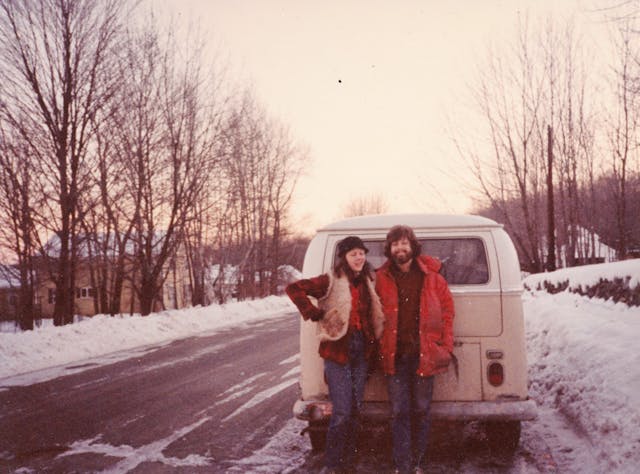
3. Fixing the 2800CS in the middle of a busy intersection
In 1988, I looked at two BMW 2800CS E9 coupes from a salvage yard north of Boston. One was a wrecked picked-over parts car, but the other surprised me by being rusty but whole, and starting and running. I bought them and decided to drive the good one home, use it as a winter beater, and part it out the following spring (I had two other E9 coupes). A few days later, Maire Anne drove me over to the junkyard in our 1983 Volvo 245GLT wagon. I slapped a plate from my daily driver on the 2800CS, jump-started its doornail-dead battery with the Volvo (incredibly foolish—I should’ve brought a fully-charged battery from another car instead), verified that no fluid was gushing out from under the engine compartment, and off we went. Through traffic. At rush hour. Ah, youth. When I was trying to get through the very busy intersection of Rt. 28 and Memorial Drive, I didn’t feed enough gas coming off the clutch, and the car stalled. Since the battery was dead, there was no re-starting it.
So, there I am in the middle of a city intersection at rush hour in a dead, rusty, uninsured, unregistered old car that looked like Beatrix Kiddo in Kill Bill II when she escaped from being buried alive. With it nearly impossible to position the Volvo nose-to-nose to the 2800CS to jump it, I motioned Maire Anne to drive the Volvo to the curb. I ran over, popped open the Volvo’s hood, yanked out its battery (also foolish, as doing so on a running car risks blowing the diodes in the alternator, but necessary), wrapped the positive battery cable in a glove so it wouldn’t short to ground, said to Maire Anne, “Whatever you do, don’t stall,” ran into the intersection with the Volvo’s battery, threw it in the 2800, started it, and drove home. Certainly not one of my smarter moves, but a good story.

4. Reconnecting the half-axle on the Vanagon
Before I began my serial relationship with Suburbans, I had Vanagons. They were weird cars but cavernous inside. I think I went through half a dozen of them before we finally bought the Toyota Previa, which also was weird but was more reliable. When I bought the first Vanagon, the clutch was slipping badly. I dropped the engine (very similar to the old VW busses—support it on blocks, unbolt the bumper, unbolt the engine, roll the bus forward) and replaced the clutch. A few days later, my sister needed to borrow the Vanagon to pick up a piece of furniture. That afternoon, I got a call from her from a payphone (this was pre-cell-phone days) saying that the Vanagon began making a loud rumble, then very loud whacking sounds came from the back.
She and the car were a few miles away. I shot over there with my tools and found that one end of one of the half-axles was flopping in the breeze. Apparently I hadn’t torqued down the ring of Allen-head bolts holding it to the flange on the transaxle. I crawled under the car, tightened things up, and sent my sister on her way. Some 35 years later, she will still sometimes needle me, “Remember when the axle fell off the Vanagon you leant me?” I, of course, will correct her and say, “It wasn’t ‘the axle.’ It was one of the half-axles. And it didn’t fall off—one end just got loose. And I came immediately and tightened it back up, didn’t I?” The funny thing is that, looking back on it, I can’t remember why I had to detach the half-axles at all. Maybe there was some reason why I needed to pull the engine and transaxle together.
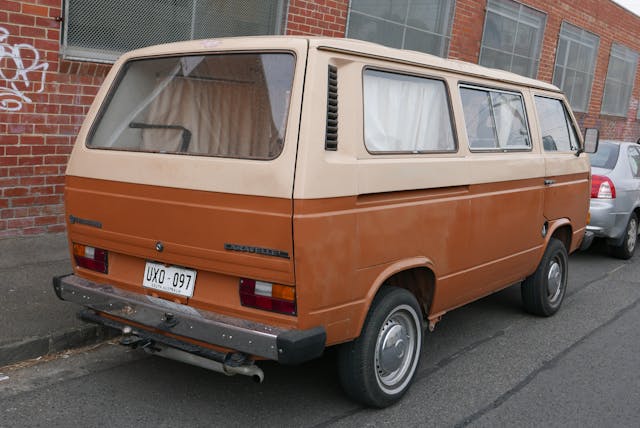
5. Unadjustable fan belt on a 635CSi
I had a 1985 BMW 635CSi that had been gifted to me by my son’s girlfriend’s father. He was mainly a Mercedes guy, and his Mercedes mechanic couldn’t figure out why the 635 wouldn’t start. It turned out to simply be a bad distributor cap. That, an air flow meter, and new injectors got the car running well, but it was by no means well-sorted, and the young man who bought it from me surprised by saying that he wanted to join my convoy on the 2000-mile round trip to The Vintage in Asheville. I warned him that this was risky. He said that he understood that I wasn’t his traveling mechanic, but I couldn’t help but feel a sense of responsibility for both him and the car. Sure enough, on the drive down, the car’s temperature began creeping up and eventually headed for the red zone.
We took the next exit. I found that the belt was slipping even though there was no audible squealing, and the slippage resulted in the water pump not continuously spinning. I tried to adjust the belt, but the bolt in the adjuster track was at the end of the slot, indicating either that the belt was wrong to begin with or had stretched. I was afraid that, if he drove the car hot, he’d crack the head, and I was about to search for the nearest auto parts store when I noticed that next door to the convenience store we’d pulled into was a machine shop where we were able to borrow a round file. I removed the bracket, and Jordan (“the kid”) did the hard work extending the adjustment slot (hey, it was his car). It worked like a charm. We later found a shorter belt, but never needed to install it.
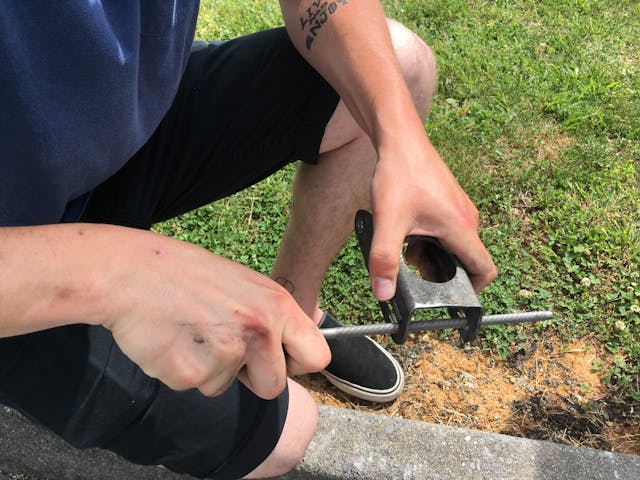
6. Cracked fan on a Euro 635CSi
I was driving my ’79 Euro 635CSi on the return trip from The Vintage—the same trip where I fixed the kid’s unadjustable fan belt. During a rest stop, I opened up the hood to check the oil and was stunned to see that two blades had flown off the belt-driven cooling fan. The 635CSi’s six-cylinder M30 engine was used in BMWs from 1968 through ’95, but it went through three different water pump, fan clutch, and fan configurations, and new parts are no longer available for anything other than the final configuration. I put out the call to friends on Facebook, but unless someone had an old fan, I’d need to replace not just the fan but also update the water pump, the fan clutch, and the pulley.
I removed the fan lest it lose another blade and slice open a coolant hose. This required removing the radiator, which in turn required dumping the coolant. Fortunately I was able to send one of my road trip companions to a nearby Autozone for a catch basin and a few gallons of antifreeze. Driving without a belt-driven cooling fan is usually fine when cruising at highway speeds, but if there’s not enough air flow over the radiator at low speeds or in traffic, it can send temperatures into the red and crack the head. I made a quick wiring mod that allowed me to run the electric pusher fan that’s in front of the A/C condenser without turning on the A/C, and let the car idle in the parking lot to test it. The temperature seemed to top out at about 3/4 of the way up the gauge, so I felt pretty good about making a run for it.
In the meantime, a friend about 150 miles north and on the way home messaged me that he had every part to do the full water pump/clutch/fan/pulley upgrade. We made it to his garage without incident, where I installed the newer-style cooling components. The car’s cooling system was fine until…

7. Leaky heater hose on the same car
A few years later, again on the way to The Vintage and driving the same ’79 Euro 635CSi, I had another cooling system issue. The irony was that, having experienced cooling system issues the last time I road-tripped the car, I wanted to be certain everything was copasetic, so I inspected the cooling system. I found a heater hose that was obviously ballooned and soft. The hose was listed as no longer available from BMW, but I found one as new old stock (NOS) on eBay. I clicked and bought it, but wasn’t certain it would arrive in time, so I hunted around on my parts shelves for a replacement. I found what appeared to be a perfectly good used heater hose. It was clearly better than the ballooned one in the car, so I installed it.
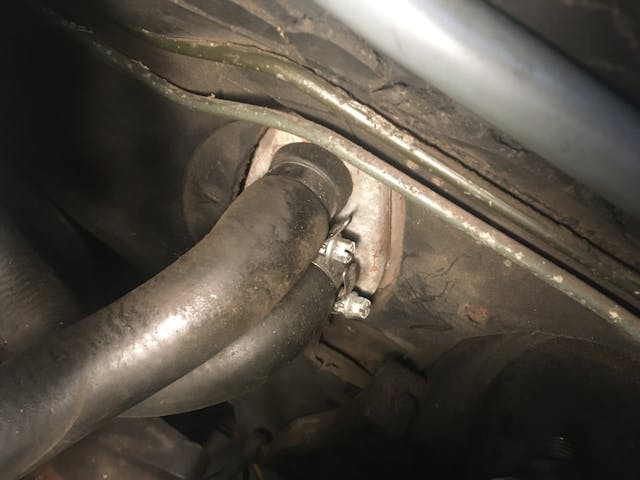
When the NOS hose arrived, I tossed it in the trunk as a spare. On the way to The Vintage, the car’s temp crept up, but did so slowly enough that I thought it was just due to the outside temperature increasing as we headed south, combined with the car rolling up and down the Blue Ridge mountains, but when it tickled the red, I pulled over. I-81 is one of the most heavily trucked routes in the country, so I made it a point to get the car as far off the breakdown lane as I could. Sure enough, the engine was peeing coolant … out the hose I’d just replaced.
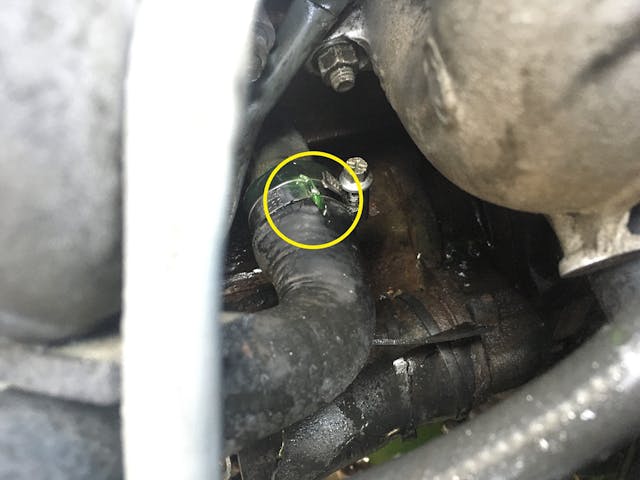
Fortunately, I had the NOS hose in the trunk. While I was waiting for the engine to cool down, I sent my travel companions for antifreeze, at which we all had a serious déjà vu, as the same thing happened with the car and the same people three years prior. It was yet another reminder how much easier these things are when you’re not trying to act like a lone wolf.

8. High beam stalk disintegrates on the Merritt Parkway
The Merritt Parkway is a windy two-lane road north of New York City with a lot of elevation changes. When I was younger, I used to love the Merritt for that reason, but in my dotage I find it stressful due to the 85-mph traffic, the sudden squeezing of two lanes down to one due to construction, the lack of illumination at night, and the repeated experience of coming over one of the rises and having to jam on the brakes due to the sudden sea of red lights. As such, I usually avoid it, but sometimes I’ll just do whatever Waze says, and if it takes me via the Merritt, so be it. Such was the case on one of my trips to The Vintage in a 2002tii.
It was night. Traffic was light to moderate, so there was a lot of toggling the stalk between low and high beams. During one such flick, the stalk fell apart in my hand. What’s the big deal, you might say? Did it fail in the low or high beam position? That was the problem. Neither—my headlights went completely out. With the Merritt Parkway’s lack of lighting, I was abruptly plunged into darkness. I slowed down while fumbling with the stalk to see if I could restore lighting. Fortunately I found one fragile position where the lights came back on, but they went out if I deviated in the slightest. I drove very carefully that way—one hand on the wheel, the other on the stalk—until I came to a rest area. On road trips, I always pack a roll of wire, a variety of connectors, and a crimping tool, so I had no question that, if necessary, I would wire the lights directly to the fuse box, but I thought that I’d first try fixing the stalk. I took the upper and lower panels off the steering column to expose the stalks and found that the potted metal tabs holding the Bakelite back of the stalk in place had broken off.
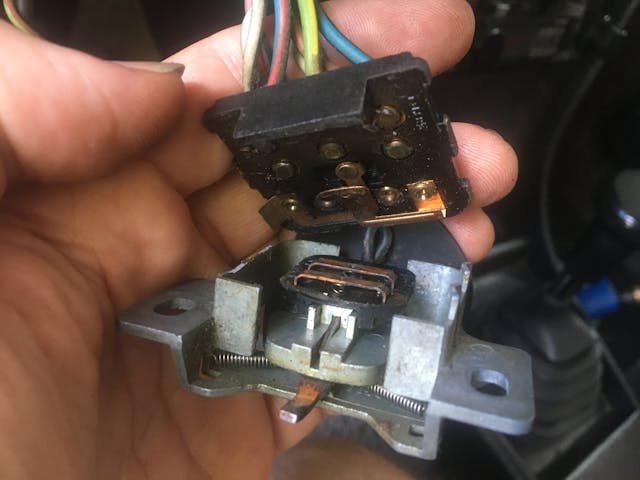
I carefully put the stalk back together, held it together with zip ties, re-attached it, and tested it. It held. For the rest of the trip, I flicked the stalk very carefully lest it fall apart again, but it’s now eight years later, and those zip ties are still in place.
9. J-B Welding a cracked head
I’d say that I’m saving the best for last, but I already wrote about the time that I J-B Welded a cracked cylinder head in a lot of detail here. It almost doesn’t count as a roadside repair, as it didn’t technically fail on the road, and as it certainly wasn’t fixed roadside—I was in a first-class repair shop with the advice of a seen-it-all mechanic—but it was still enormously satisfying to stop the dripping of oil out a crack at the top of the head onto the exhaust manifold using J-B Weld and be driving home a few hours later.

How about you folks? What was your favorite roadside repair? Wipers pulled back and forth with rope? Throttle controlled with a hand-yanked cable? Tell me what you’ve got.
***
Rob’s latest book, The Best Of The Hack Mechanic™: 35 years of hacks, kluges, and assorted automotive mayhem is available on Amazon here. His other seven books are available here on Amazon, or you can order personally-inscribed copies from Rob’s website, www.robsiegel.com.
Check out the Hagerty Media homepage so you don’t miss a single story, or better yet, bookmark it. To get our best stories delivered right to your inbox, subscribe to our newsletters.
Marketplace
Buy and sell classics with confidence













First; Do not attempt a long trip in a non-American car, parts that can be found along the way.
Fix any ‘iffy’ items before you go, have basic tools along, a few key parts, like a coil, condenser & points.
I found an axle & rear wheel bearing 1200 miles from home for my ’54 Ford, American tools fit American cars and easy to come by, a little common sense goes a long way. This isn’t Europe, don’t expect it to be.
30-some years ago, I was driving from near Baltimore back home to rural Pennsylvania, and about halfway there my 67 Beetle just plain died, and a strong fuel smell hit my nose. I popped the decklid to find that the little brass tube that is normally pressed into the fuel pump had come loose and was still stuck in the hose to the filter. In the process of removing it from the hose, I dropped it, right into the uncovered pre-heat port on the muffler. After an hour of brainstorming, I found that the stem of the door lock knob was just the right diameter to fit into the pump. A quick snip with the pocketknife, and I was back in business. It lasted long enough to get me to my destination, which was good enough for me!
I had a ’65 Mustang 3-speed that was held together with rust and one of its endearing features was its weak windshield wiper motor (ran best when sunny and dry). Anyway I was coming home from college one winter day and the snow started to come down fast and heavy and soon the wipers had stopped working all together. I pulled over and yanked the laces out of my connie high tops, tied them together and then to the tips of the wipers and brought the ends in through the driver and passenger windows. I was able to make it home the final 20 miles pulling the wipers back and forth while steering with my knees. Good times….
I was hoping that SOMEONE would post having to do the shoelaces-moving-the-wipers trick!
Rob’s adventures brought back a lot of memories for me.
My first. It was spring of 1968. I was a freshman at Case Tech in Cleveland (now Case Western Reserve University). Friday night and a plan to visit my grandparents in Pittsburgh for the weekend. 30 minutes into the drive and my Triumph Spitfire’s light started to go dim. I drove back to the dorm and borrowed enough tools from fellow dorm mates to pull the generator. Within an hour, I had the armature cut, the brushes re-seated, the generator reinstalled and I was back on the road.
Fast forward many years and my family and I were traveling cross country in an older motorhome. In Arkansas the engine felt like it was loosing power on acceleration, so I stopped at a parts house and bought a fuel pump “just in case.” The next day we were on I40 in Oklahoma, 100 plus degrees out, when the engine died. I limped the motorhome to a spot under an overpass and changed out the fuel pump (by then I learned to always keep tools in the vehicle). My young son, who now makes his living in the automotive business, was amazed that I knew that we would need a fuel pump (actually just a lucky guess) and that it could be replaced on the side of the road.
Finally, I was turkey hunting, by myself, in the back woods of the Ozarks in my wife’s 1965 Volvo station wagon. On a single lane dirt road (more of a dirt path) in the middle of the night, the lights went out on the wagon. I stopped the engine (no place to pull over), popped the hood and checked the fuse box (Volvo, why would you ever put a fuse box under the hood?) I found that one of the headlight fuse connectors broke off. I cut off the wires on either side of the fuse, stripped the insulation off and wrapped the bare ends together. Problem solved.
I’ve had to make a few oddball repairs on the side of the road. When I was 18, I was headed home and had just turned on to route 128 from the Mass Pike, when I lost all throttle control of the 327 that had been planted in my 1962 Nova. I had used a throttle cable that was in the last car the engine was in and It had snapped. This repair was pretty straight forward as I found some string and weaved it from the carburetor under the hood and into the car vie the vent window. Now it may seem like that was no big deal, but I have to say until you have tried to use a piece of string to work a carburetor while driving a car on the highway you would think otherwise.
There are many times when I would have to jury rig something and one of the craziest was when I was test driving a client’s car and I was about 10 miles from the shop. The car just started to stumble and lost power and stalled. I’m on the side of the road, no tools, no phone, so I tried to troubleshoot the problem. I am alone and fortunately The 12 cyl Jaguar XjS, has a starter relay under the hood. This allowed me to remove the actually starter solenoid wire to touch it to a power pot that is located nearby. This allowed me to crank the car with the ignition on to check for spark at the dist cap, which was there. So to the back of the car and in the trunk is where the fuel pump is and I knew where the fuel pump relay was, but how was I going to test it. I took a lamp from the trunk light, they use bullet type bulbs and now I needed some way to turn it into a test light. While rummaging in the trunk there was a picture and in the back was a wire used to hang it. I unwrapped the bare picture wire from the back of the picture, and then chaffed it along the rain gutter after peeling away the trunk rubber . This allowed me to end up with 2 pieces, which I wrapped around the end of the bullet lamp. I now had a test light although it was crude it allowed me to test the relay by pulling the relay out of it’s socket just enough to be able to touch the terminals with my makeshift lamp.
after fiddling around I was able to determine power in but no power out. So I used a piece of the wire and stuffed it in the hot side of the relay to the out or pump side and the pump started humming. I returned the starter wire to the relay and packed everything up and off I went.
Picture wire for the win!
I was 23. It was one of those very rare and very hot summer days in Portland. Portland is about 80 miles inland from the coast. A bunch of my friends and I decided it would be a great day to drive to the coast to cool off as it’s always about 10 to 15 degrees cooler than Portland in the summer. I recall being the one with gas money and a vehicle so I became the designated driver. We all piled into my 1951 Chevy half-ton pick-up – three in the cab and three in the back. Looking back on this and many other misadventures in my motoring youth with the eye of a husband and parent I can’t believe I didn’t see the danger of this setup. The ignorance of youth.
I always carried a small toolbox wherever I went in my truck because you never knew when you were going to need to fix some broken bolt, loose belt or leaking tube. This particular truck had a habit of stalling out every so often because the fuel filter would clog up. I kept a half-inch open-end wrench in the toolbox for just such an event. The fix was simple: Just take the wrench and disconnect the fuel line from the filter and the line from the filter to the carburetor and suck out the fuel and whatever gunk was clogging the filter, reconnect the fuel lines to the filter, turn the engine over a few times to get the gas flowing again and you were off on your merry way. It took less than 5 minutes and I had done it so often it was routine.
The main road along the Oregon coast is Highway 101. It’s one of the most scenic roads in the country and winds its way from the Canadian border all the way to the Mexican border. We were on a particularly winding and hilly section of 101 heading up a steep incline when the truck started to stutter and chug. I had plenty of gas so I knew that this was my infamous clogged filter acting up. I managed to get over onto a very narrow shoulder. It was not a good spot to be stopped but I figured I’d only be there for a few minutes while I did my surgery. I told everyone not to worry. I had it under control. I tilted the seat back forward to get the toolbox from behind the seat. It wasn’t there. I looked under the seat. It wasn’t there. Then, to my chagrin, I remembered that I had taken the toolbox out to work on something at my house and had not returned it. Damn! Here I was parked on a hill in a very bad place, miles from anyone and certainly nowhere near a hardware store or garage. I was really upset with myself.
After ranting around for a few minutes, I asked everyone to get back into the truck. I had noticed that there was a wide gravel pull-off at the bottom of the hill we had just come up. I figured it was better to get there and park than stay where we were.
I released the parking brake, slipped it into neutral and began to slowly coast backward down the hill keeping one side of the truck on the asphalt and the other on the shoulder. After a scary couple of minutes, I was able to coast the truck safely into the pull-off.
Angry at myself for screwing up an otherwise splendid day at the beach with my friends and trying to figure how I was going to get us all out of this mess, I opened the truck door and stepped down onto the gravel. As I did so, I glanced down at my foot and noticed a glint of chrome. I bent over to see what I was seeing and there it was – a brand new, 4” long Crescent wrench. By the look of it appeared to have never been used. I couldn’t believe my luck. There is a God! I popped the hood, did my little filter trick with the aid of my new tool and we were off.
Life is good.
This roadside repair was from back around 1979: there were dozens of eligible ‘war stories’ from before, and since…even recent ones.
BF, now hubby, and I were taking his 2 y/o Mazda Rotary truck from southern Ohio up to Winnipeg, Canada to view and photograph a total solar eclipse, in the depths of winter. Yep, young, and ambitious (read that as dumb).
Shortly after pulling out of a rest area outside of Nowhere, ND, the fuel pump quit. We had it towed (thanks AAA!) into the nearest town and dropped at the town’s only gas station. As luck would have it, close by sat a Mazda rotary wagon on the station’s death row, to pinch a fuel pump from. As luck would have it, we were told that was the station owner’s wife’s car and it was off limits.
This was early evening on a Saturday, no parts at the station, and the town’s parts store was closed. But, the station attendant knew the town’s parts shop guy and phoned him at home asking him to open up his shop to sell us a fuel pump.
Hubby and I took turns loosening the bolts holding the bad fuel pump on, while laying in a congealed puddle of diesel fuel. We could only deal with the temps for a short time (as it was after sundown now, and it was below 0 when the sun was out) before our fingers froze. It took a while, but we got the new pump on, and continued on our way. The trip was also memorable because of the great photos we got of the eclipse, and the challenges with the photography due to the extreme cold and amount of snow.
Yes I remember driving our 70 VW Buss from Chicago to Vermont. I can’t count how many times I had to regap the points, and yes with a matchbook cover!!! I had a great laugh when I read #2 above!!
My shining moment was not on the road but on the lake in the early ’90s. Two friends and I were cruising the lake in my parents’ boat when the engine just died. It did this twice a couple of years prior, but each time, it started working before we could find the problem. Everything had power. The engine would crank, but no fire. It was a mid-80s boat with electronic ignition with a carb. Unfortunately, the only tool on the boat was my pocket knife. Knowing the tank was full because I just filled it 1/2 hour ago, I didn’t suspect fuel to be the problem because it just stopped like the key was shut off. It had to be ignition.
I quickly did a spark test between a plug wire and the engine. Nothing. Then, I pulled the power wire from the coil, shorted the ground side, and checked for a spark from the coil directly. Nothing. So either the coil is toast, or it has no power.
In the meantime, we are drifting towards a rocky bank. With one paddle in the boat, my two friends are taking turns paddling like their life depends on it.
Since it happened once before, I guessed that the coil is okay, and something in the wiring was not sending power to the coil. I crawled under the dash, sacrificed the horn wire, stripped it, and connected the coil directly to the battery. The engine fired. We were 5 feet from the rocks and took off to home like we stole the boat.
When we got home, I took the hotwire off, and wouldn’t you know it, it ran like nothing was wrong again.
My parents kept the boat for 5 more years. It never did it again. Go figure.
All the side of the road repairs I’ve also done were blatantly my own fault. It’s not nearly as exciting, but I did get very efficient at changing pushrods.
I was in the middle of an intersection – waiting for a car to pass so I could turn into the gas station – and my car ran out of gas before I could complete the turn. We had to push it into the gas station. I had just bought the car from a private individual – that failed to mention the fuel gauge was off when it indicated below a quarter tank.
Had a ’58 Flathead Gray Marine Straight 6 in an old 20′ Trojan plywood cuddy cabin back in college.
After a FULL day out on the reservoir it was getting on dusk and time to get the old girl going for the trip back to the launch. All we got was some sputtering… After some quick diagnosis, we found the distributor’s rotor had a carbon track shorting to the shaft. With no spare, we eventually took a piece of 12 gauge stranded wire, cut it to length and fashioned a new rotor by removing insulation off the end and digging a hole in the insulation to expose copper over the center. A piece of electrical tape held it onto the top of the shaft and away we went. Lesson learned… ‘Never ever give up if you have a few tools, wire & tape…’
There seems to be a theme, Stay the hell away from BMW’s. You expect the GT6 to break so it doesn’t really count.
I suppose that’s fair :^)
Fuel pump died on a steep road. After getting to the side I walked a few miles in the rain to a parts store and got a replacement. The next couple of hours were spent on my back replacing the thing while rain water poured down the gutter I was laying in.
Like Rob I’ve had many roadside adventures with less-than-stellar rides, but can’t top my friend’s. We were members of the Scuderia-X sports car club and raced in the EMRA organization at Bridgehampton, NY in the 1970s. He was flat-towing his 50s Deutsch-Bonnet (Google it!) 100 miles from New Jersey when the engine in his Panhard tow vehicle blew sky-high on the George Washington Bridge. He was able to coast into a breakdown cutout. Since the tow car sported the same basic two-cylinder, air cooled powertrain, he yanked the race car’s engine and put it in the tow vehicle, and proceeded to the track, where he put the engine back into the race car and raced all weekend. Sunday night he pulled it again, put it back in the tow car, and drove the 100 miles home.
A while later he borrowed a more robust tow vehicle and trailer and towed the car to Sebring, where he completed the 12-hour enduro. He always raced using retread Michelins that were available back then. He claimed that rubber from other cars’ race tires left on the track would stick to his Michelins, so they never wore out!
He was a prep school French teacher and claimed he knew nothing about cars and mechanics until he got interested in Panhards and the racing history of Deutsch-Bonnets, and went out and bought a few derelict ones and got them back on the road.
I was driving my ’71 Celica to work on a cold morning in Atlanta. While stopped at a red light, the rubber heater hose under the dash ruptured and almost immediately the interior was filled with hot steam. Luckily I could see a store just ahead, so I drove with my head out the window and pulled in. Once I realized what had happened, I simply changed the HVAC control from heat to vent, and water no longer was routed through the broken hose. But the short drive and loss of water was bothering my temp gauge. So, I scrounged around the store’s trash and found a Coke bottle (after all, it was Atlanta), and used it and a nearby spigot to replenish the lost water in the radiator. Drove it like that until I eventually got around to finding the 6-inch culprit under the dash and replaced it.